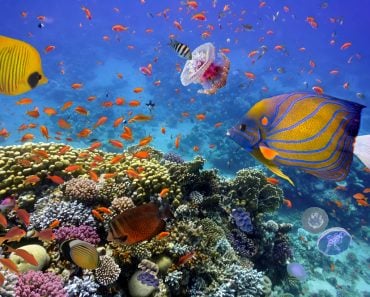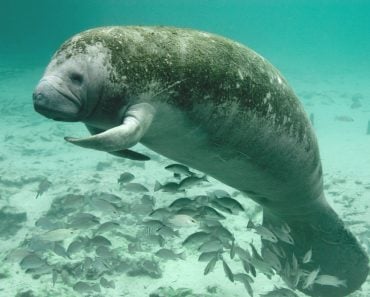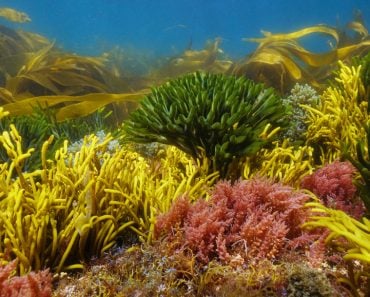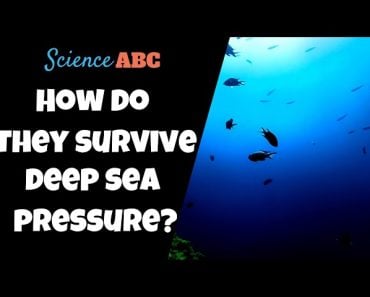The deep sea lacks plant life, which would require sunlight to make food. However, even without the sunlight that fuels life on the surface of the Earth, deep sea creatures have adaptations that allow them to make this habitat their home, including those for hunting, feeding on decaying matter, and even harboring bacteria that can make food without sunlight.
Plants play a pivotal role in sustaining life on Earth by providing a wealth of essential resources. They do this by using the energy of the sun to spark elaborate chemical reactions that give us food and oxygen. However, the deep ocean, a mysterious and profound abyss that encompasses over two-thirds of our planet’s surface, presents a unique challenge. Sunlight only reaches the ocean’s highest 200 meters, where photosynthesis is possible. Lower than that, the deep sea begins, which is a world of bone-crushing pressure, cold, and total darkness. These conditions are so extreme that they seem inhospitable to life…
But not so! We’ve found a thriving ecosystem there, one that is teeming with fascinating, albeit bizarre organisms.
So, how can life survive in the deep ocean without light? Are there plants down there producing food?
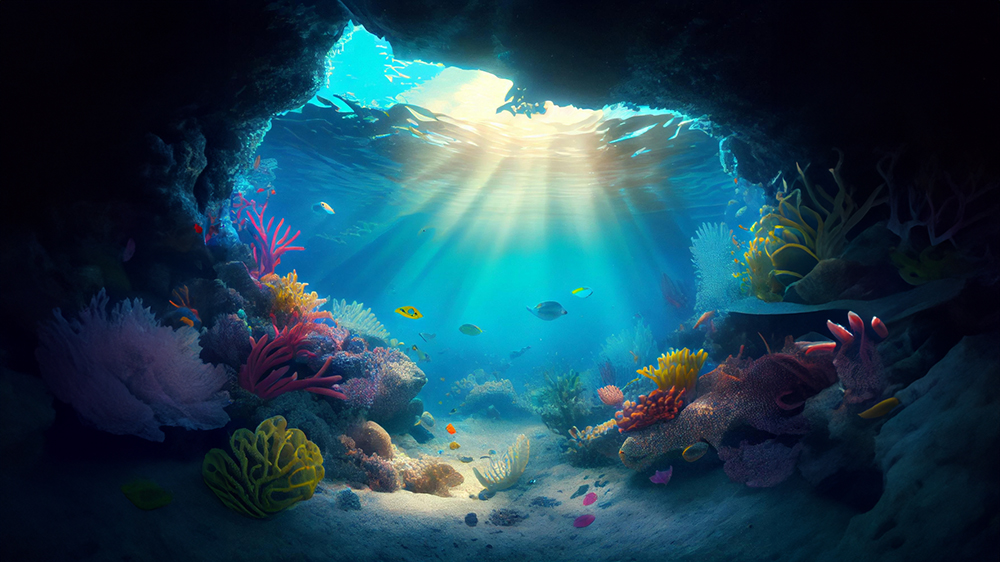
Recommended Video for you:
The Deep And Dark Ocean: A Hostile Environment
The deep ocean refers to areas at a depth greater than 1,000 meters from the ocean’s surface. At that depth, sunlight fails to penetrate, resulting in total darkness. This stands in stark contrast to the lush and abundant plant ecosystems found in many other environments on our planet.
The deep ocean is generally divided into several zones, with the Bathyal, Abyssal, and Hadal Zones representing the twilight, midnight, and trench realms, respectively. The Hadal Zone extends to a staggering depth of 6,000 meters.
In these zones, life looks very different from what we see closer to the surface, both on land and in water, as the conditions differ so greatly. At the deepest parts of the ocean, such as the Mariana Trench, the pressure can reach an astonishing 15,000 psi (pounds per square inch), which is over one thousand times greater than atmospheric pressure at sea level. In the Abyssal Zone, temperatures can hover around 2-4°C (36-39°F), which is much colder than the surface waters. On top of this, nutrients—including essential elements like nitrogen and phosphorus—are often limited in the deep ocean. Without an adequate nutrient supply, organisms face challenges when it comes to sustaining life processes.

The lack of sunlight and minerals, immense pressures, and low temperatures (among other conditions) has given the life that exists there a number of unique adaptations. However, these extreme conditions mean that plants, most of whom require sunlight to thrive, are absent.
Now, without plants and their reliable processes of photosynthesis, how does life in the deep oceans get its food? What forms the foundation of the deep-sea food web?
Chemosynthesis: A Lightless Process
To compensate for the absence of sunlight, deep-sea organisms have tapped into an ingenious alternative energy source known as chemosynthesis. This process synthesizes food using inorganic molecules present in the deep sea as the primary energy source, unlike photosynthesis, which depends on sunlight. This allows organisms to thrive in extreme environments, including hydrothermal vents, cold seeps, and deep-sea methane seeps.
At the heart of chemosynthesis are chemosynthetic bacteria, which play a pivotal role in converting inorganic compounds, such as hydrogen sulfide (H2S), methane (CH4), and elemental sulfur (S), into organic molecules. These organic compounds serve as the foundation of the food chain in the deep ocean, sustaining a variety of unique organisms that are specially adapted to their harsh habitats.
At hydrothermal vents, specialized bacteria known as sulfur bacteria play a crucial role in the chemosynthetic process. These bacteria metabolize the chemicals from the hydrothermal vent fluid, providing the base of the food chain for other vent-dwelling organisms, including giant tube worms, clams, and shrimp. Through chemosynthesis, these organisms can thrive in an environment entirely devoid of sunlight.
This makes chemosynthetic bacteria crucial for feeding the myriad organisms in the deep sea, as they are the base layer of an expansive food web.
The Remarkable Organisms Of The Deep Ocean
The remarkable Giant Tubeworms (Riftia pachyptila), which can reach lengths of over two meters and are often found near hydrothermal vents, house chemosynthetic bacteria within their bodies and rely on the nutrients produced by these microbes.

Deep-sea mussels are another example of symbiotic organisms. They have specialized gill tissues that harbor chemosynthetic bacteria, allowing them to obtain nourishment from the minerals and chemicals in hydrothermal vent fluids. Deep-sea clams, similar to mussels, also host chemosynthetic bacteria in their gill tissues. These creatures have adapted to thrive in the extreme conditions surrounding hydrothermal vents. Additionally, tiny vent shrimp congregate near hydrothermal vents to feed on chemosynthetic bacteria that grow in abundance in these areas.
Chemosynthesis Chemistry: How It Works
So, how does chemosynthesis work?
For starters, let’s look at how photosynthesis works. Photosynthesis uses light energy to convert carbon dioxide into sugars. This is the process of light energy being converted to chemical energy. In chemosynthesis, the energy in molecules like hydrogen sulphide and methane are used to convert carbon dioxide into food. Essentially, chemosynthesis converts the chemical energy of one molecule into the chemical energy of another molecule.
In brief, chemosynthesis occurs like this:
6CO2 + 6H2O + 3H2S → C6H12O6 (Sugar) + 3H2SO4 (Sulfur Compounds)
In this reaction, hydrogen sulfide is oxidized to produce sugar—glucose, in this case. This glucose serves as the fundamental energy source for bacteria and other organisms that form the base of the food chain in chemosynthetic ecosystems.
These incredible relationships in the deepest corners of our planet should remind all of us just how adaptable and diverse life on this planet can be.
Dead Matter From Above: A Lifeline From The Surface
Chemosynthesis alone doesn’t account for all life in the deep ocean. The Aphotic Zone is not only devoid of sunlight, but also home to another important source of energy: dead matter that falls from the surface waters. In the upper layers of the ocean, microscopic plants called phytoplankton engage in photosynthesis, capturing energy from the sun and creating organic matter, which is then fed on by myriad species, passing upwards through the food chain.
As life in the upper regions of the ocean—the phytoplankton, fish, and whales—die, their remains slowly sink into the depths. This organic debris sinks to the ocean floor, something marine biologists have poetically dubbed marine snow. This organic detritus is a critical source of food for many deep-sea organisms that are incapable of engaging in chemosynthesis. The carbon-rich particles that make up marine snow provide nourishment for filter-feeding animals like sponges, corals, and certain species of zooplankton.
As it descends into the deep ocean, marine snow serves as a connecting bridge between the two worlds, providing energy to animals that might otherwise struggle to find a stable source of sustenance. The deep-sea organisms that can’t access or utilize chemosynthetic hotspots rely on this organic matter falling from above to sustain their existence.
Conclusion
Some of the most remarkable adaptations in deep sea region include gigantism, with colossal squid and giant isopods growing to astonishing sizes to endure long periods between meals, as well as translucent bodies that render creatures nearly invisible, and pressure-resistant structures that keep organisms from collapsing under the immense weight of the ocean above.
Moreover, the deep sea fosters extended lifespans in species like the Greenland shark, enabling them to thrive with their slow metabolism, despite limited food resources.
Understanding the secrets of the deep ocean isn’t merely a matter of scientific curiosity; it’s essential for the preservation of these unique and delicate ecosystems. In the face of climate change and the potential exploitation of deep-sea resources, ongoing exploration and conservation efforts are vital. By doing so, we can ensure that the deep ocean’s wonders continue to captivate and inspire us for generations to come.

